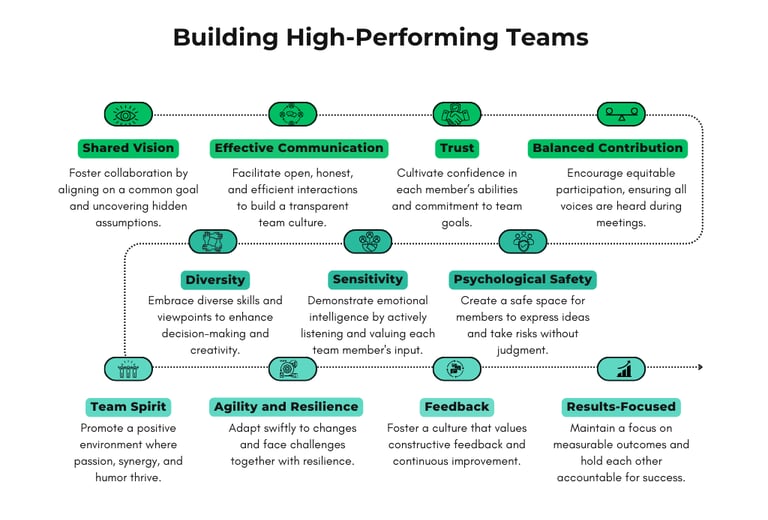Cultivating High-Performing Teams
Explore the key characteristics of high-performing teams, including shared vision, trust, diversity, and psychological safety. Learn how team leaders can facilitate exceptional collaboration.
PROJECT TEAMS
Iyanna Trimmingham
10/20/20232 min read


Ever been part of a team that just clicked? You know, where everyone's on the same page, working towards a common goal, and communication is a breeze? If you have, you get how special being in a high-performing team can be.
We've all felt that energy when you walk into a room where ideas flow freely, decisions are made thoughtfully, and conflicts get sorted out like pros. It's a place where trust and psychological safety rule, making everyone feel comfortable speaking up.
But let's be real – high-performing teams don't pop up out of nowhere. It takes intentional effort to build and nurture these extraordinary groups. Now, let's break down a few key factors that make successful teams stand out:
Shared Vision: Having an inspiring goal or mission brings focus and fosters collaboration. Knowing each team member's motivations, working styles, and values aligns expectations and behaviors. Spending time uncovering hidden assumptions prevents future conflicts.
Effective Communication: High-performing teams talk often, either face-to-face or over video chat. Face-to-face is king for brainstorming and decision-making. Email and texting fall short for complex tasks; video chat steps in when in-person meetings aren't doable. Good communication is open, honest, and efficient, creating a culture of transparent and empathetic interaction.
Trust: Trust is vital. Team members must have confidence in each other's abilities and commitment to the team's goals. Building trust takes time, but it can vanish if members feel exploited or doubt reliability.
Balanced Contribution: In top-notch teams, everyone contributes during meetings. No one hogs the conversation, and no one stays silent. Team leaders play a crucial role in encouraging all voices, ensuring everyone's perspective is heard.
Diversity: High-performing teams thrive on diversity – in skills, backgrounds, and viewpoints. Different perspectives lead to stronger decision-making and problem-solving as team members challenge assumptions and encourage creative solutions.
Sensitivity: Effective leaders have high emotional intelligence and social sensitivity. They read people well, listen actively, and create a culture of trust and respect. Decisions consider all perspectives and feelings, fostering an environment where individuals feel heard and valued.
Psychological Safety: Members in high-performing teams feel safe taking interpersonal risks. A non-judgmental team leader sets the tone, encouraging members to share personal stories and emotions, fostering empathy. It's the foundation for expressing ideas, questions, and concerns freely.
Some more traits of high-performing teams:
Team Spirit and Chemistry: There's genuine excitement, passion, and synergy. Members enjoy working together, supporting each other with room for humor alongside serious work.
Agility and Resilience: These teams adapt to changes swiftly and face challenges united, showing resilience in tough times.
Openness to Feedback: They actively seek and handle feedback constructively, with no room for ego or defensiveness.
Results-Focused: While relationships matter, high-performing teams stay focused on measurable goals. They hold each other accountable, with data guiding their decisions.
As a team leader, remember these dynamics. Avoid being a control freak; instead, facilitate the group's talents. Show humility, acknowledging your fallibility. Prioritize face-to-face interactions, understand what motivates each team member, and encourage mutual support. In a psychologically safe atmosphere, individuals bring their authentic selves to work, leading to high performance. And remember, always keep it real!

